This article was co-authored by wikiHow staff writer, Dev Murphy. Our trained team of editors and researchers validate articles for accuracy and comprehensiveness.
wikiHow’s Content Management Team carefully monitors the work from our editorial staff to ensure that each article meets our high quality standards.
There are 9 references cited in this article, which can be found at the bottom of the page.
wikiHow marks an article as reader-approved once it receives enough positive feedback. In this case, 96% of readers who voted found the article helpful, earning it our reader-approved status.
This article has been viewed 1,234,868 times.
Learn more...
Counting cards is used in blackjack to give a player an edge over the casino. Contrary to popular belief, counting cards doesn't require any type of Rain Man-like savant qualities, nor is it illegal...it's just highly frowned upon. So if you start counting cards, you'll have to learn to be incredibly stealthy, but that’s a job for another article. Right now, we’re gonna walk you through just how to count cards so you can clean house at your next blackjack game. Remember us when you win big!
Things You Should Know
- To use Hi-Lo (the most common card-counting strategy), assign a value to every card. Keep a running count based off of each dealt card’s values.
- Calculate the count per deck, also known as the “true count.” Keep changing your bets as the true count increases.
- Camouflage your strategy by making moves slowly and pretending you're interested in other things.
Steps
Hi-Lo Strategy
-
1Learn how Hi-Lo works. Hi-Lo is by far the most popular card counting strategy. In this strategy, if the ratio of high cards to low cards is higher than normal (that is, there are lots of high cards still in the shoe), the player can make bigger bets to increase the amount they can win when the deck is favorable. They keep a number in their heads that tells them when to bet and how much to bet—or not to bet at all![1]
- A deck with a positive number is good. The higher the number, the more you want to bet. The higher the number, the more high cards are left to be played.
-
2Memorize the values of each card. To track the ratio of high cards to low cards (thus knowing whether the deck is in your favor or not), you'll need to assign the cards a value. Start at 0 and as each card comes up, add it to your tally.[2]
- Cards 2-6 have a value of +1.
- Cards 7-9 have no value.
- Cards worth 10 have a value of -1.
- Aces also have a value of -1.
Advertisement -
3Increase your bets when the count is running positive. "Positive" means about +2 and above. The higher the count, the more you should bet, but keep in mind that if you range your bets too much, you might draw some heat from the casino.[3]
- Generally speaking, you want to increase your bet by a unit of 1 for each point that the tally goes up. If you do it any more drastically than that, those eyes in the skies will be on you like a hawk.
-
4Test yourself: grab a deck (sans jokers) and rifle through it, keeping track. You should end up at a very round 0 if you've counted the cards accurately. Aim to get through the deck in under 25 seconds. That way, even Dealer McSpeedy won't get by you.[4]
- Start timing yourself when you can get through the deck and end up at 0 every time. Even though the math is very simple, it's easy to get side tracked. Don't be surprised if you end up with a different number consistently in the beginning stages.
- Take a card out and leave it face down. Run through the deck and get your tally—what's the unturned card?
-
5Add pairs rapidly, viewing them as a single number rather than an equation. If you look at a jack and a 4, your thought process should not be, "-1 and +1 = 0." It should simply be, "0." When you see a low card and a high card, they cancel each other out. Keeping this in mind will make it much easier as the cards fly by you at lightning speeds.[5]
- Counting cards is about remembering a tally. Counting cards well is about accuracy and speed. To be a good card counter, it has to be like riding a bike—you can go on autopilot at the drop of a hat. Taking in pairs gives you a lot less to worry about, making it easier for you to be accurate.
-
6Divide the running count by the decks waiting to be dealt to get the true count. Long gone are the days when casinos work with just one deck (mostly, at least). It's a lot more common to run into a game that is working with 5 or 6 (in what's called the shoe). Because of this, your running count may not be the true count. To find the true count, divide the running count by the number of decks waiting to be dealt. If your running count is +4 and there are 4 decks left, the true count is actually +1.[6]
- To know how many decks are left, take a covert look at the discard tray. Do this between hands, when you have the extra bit of time.
- If you are working with a single deck, invert and multiply. Say you have 3/4 of a deck left and the count is +4. You would then multiply 4 x 4 to get 16 and divide it by 3 (a little over 5). Some people choose just to go with the running count in a single deck, but know that the true count is always a little bit different (higher, regardless).
Advanced Card Counting Techniques
-
1Use Hi-Opt II for added insurance. Hi-Opt II has the highest insurance correlation (IC) of all the strategies, plus an additional Ace count. Hi-Opt II is similar to Hi-Lo: simply memorize the card values and add them up throughout the game. Cards numbered 4 and 5 are valued at +2, while cards 2, 3, 6, and 7 are valued at +1. Cards 8 and 9 are valued at 0, and 10s and face cards are -2. When the count is high, bet more often; when the count is low, don't bet.
- In Hi-Opt II, Aces are valued at 0.
- Hi-Opt II and Omega II have the highest playing efficiency (PE).[7] The PE determines decisions and deviations (when you change from basic strategy) in play.
-
2Try Omega II to track Aces carefully. In Omega II, 4, 5, and 6 are worth +2. 10, J, Q, and K are worth -2, and Aces are worth 0.[8] When the count is positive, it means that more low cards are in the dealer's deck, while when the count is negative, it means there are higher cards in the dealer's deck.
-
3Try "wonging," or back-counting, before you join a game. It is called "wonging in" when you stay away from a table until it's hot enough to warrant joining. When the table grows cold, you "wong out." It's typically done on bigger decks, otherwise you'd be getting up as soon as you sat down.[11]
- Lots of casinos have banned mid-shoe entry for this purpose. If you do consider doing this, know that it looks fishy to even untrained eyes. How else would you know when to swoop in for the kill if you weren't counting cards?
- The suspicions you do avoid, however, are changing your bets. When you're wonging, you bet the same exorbitant amount every time.
Camouflaging Your Strategy
-
1Act like a tourist. If you don’t want to be caught counting cards, don’t look like a card counter. Card counters are notorious for playing blackjack for hours and hours, often without eating or enjoying the amenities available at the resort. Acting like a tourist just looking for a simple good time may take the suspicion off of you.[12]
- Blend in. Busting out your three-piece Armani suit is not what you want to do when starting your card counting career at your local casino. Leave the Italian suede at home and act like a regular Joe.
-
2Let your bet ride, if you need to increase the bet. Dealers are trained to shuffle the deck upon an unexplainable increase in the bet. For this reason, only up your bet in small increments and at seemingly random points in the game.[13]
- This may seem counterproductive to making money, but if you get thrown out, you'll be making zero. No, card counting isn't illegal, but it is heavily frowned upon and you can be asked to never return to the establishment.
-
3Appear to be interested in other things besides the game. If you’re so busy counting your lips are practically moving, it's a dead giveaway. Go ahead, get a drink, make small talk. Enjoy yourself.[14]
- You need to be proficient enough at counting that you can carry on a conversation. Chat with the dealer about how their day is going. If the pit boss comes up, chat with him, too.
- When you practice counting cards at home, turn on the TV and radio, and maybe have some small kids around, if you can. Practice getting used to counting amidst total chaos; this will simulate what it's like counting in a casino.
-
4Tip the dealer. You should tip anyway, as it's courteous. But tipping will make the dealer like you. Many dealers know how to count cards, but a dealer that likes you will be more likely to wait before shuffling on a favorable deck and shuffle sooner on a bad one.[15]
- A dealer can help you or hurt you. Motivate the dealer to be for you. Same goes for the entire pit crew—get them on your side, and your not-so-heinous crime may slide under their radar.
-
5Be aware of cameras and security guards. At any time, there are hundreds of cameras in the casino in addition to the eyes of the dealers, those in the pit (behind the tables), and the security staff. If they'll catch a waitress for serving a customer every 18.37 minutes, they'll definitely have the attention span to monitor you. Because of this, it's very important to be on your best behavior.[16]
- If a casino suspects you're counting, they probably won't come right out and say it. They may have someone start a conversation with you to distract you, assign you a high-speed dealer, shuffle spontaneously, or change the betting rules. If any of these happen, back down slowly, but immediately.[17]
-
6Make your moves slowly to avoid suspicion. When you hit a table, stay there for a spell. Why would you leave? And when you make your moves at this table, take a second to think about it. We know, we know, we said you should be so good you’re a machine, spitting out the perfect card without thinking about it, yada yada. But normal blackjack players haven't spent the past three months practicing this exact setup, so don’t act too quick here, or you’ll stand out. Everything you do needs to be nonchalant and casual.[18]
- Do not jump from table to table every time the deck sours. This will bring you to the attention of the casino personnel fast. Make minimum bets until the deck is richer. Increase casually because you're doing well—not because you know what's about to come.
Community Q&A
-
QuestionShould I just count my own cards or should I count the cards of other people?
 Community AnswerIf it comes out of the shoe, count it. Your cards come from the same place as other people's cards. You need to count all the cards - yours, other players', and the dealer's.
Community AnswerIf it comes out of the shoe, count it. Your cards come from the same place as other people's cards. You need to count all the cards - yours, other players', and the dealer's. -
QuestionWhat should I expect to be dealt if the count is zero?
 Community AnswerIt means anything can be next, but expect mostly ten-pointers on blackjack, as there are four times the amount of them.
Community AnswerIt means anything can be next, but expect mostly ten-pointers on blackjack, as there are four times the amount of them. -
QuestionHow much is four pairs of trump worth in pinochle?
 Community AnswerPairs in pinochle aren't worth anything; marriages and runs in trump are, though.
Community AnswerPairs in pinochle aren't worth anything; marriages and runs in trump are, though.
Warnings
- Although the odds are in your favor, it will require about 6 hours of play to guarantee the odds will come to fruition (even a coin flipped 10 times could land on heads for 7 of those).⧼thumbs_response⧽
- Don't play with money you can't afford to lose, especially while you're learning. Variance can cause losses even if your strategy is perfect.⧼thumbs_response⧽
References
- ↑ https://wizardofodds.com/games/blackjack/card-counting/high-low/
- ↑ https://wizardofodds.com/games/blackjack/card-counting/high-low/
- ↑ https://wizardofodds.com/games/blackjack/card-counting/high-low/
- ↑ https://wizardofodds.com/games/blackjack/card-counting/high-low/
- ↑ https://wizardofodds.com/games/blackjack/card-counting/high-low/
- ↑ https://wizardofodds.com/games/blackjack/card-counting/high-low/
- ↑ https://www.qfit.com/card-counting.htm
- ↑ https://www.casinonewsdaily.com/blackjack-guide/the-omega-ii-blackjack-card-counting-system/
- ↑ https://www.blackjackgala.com/counting-cards/wong-halves/
- ↑ https://www.casinonewsdaily.com/blackjack-guide/the-ko-knockout-card-counting-system-in-blackjack/
- ↑ https://www.blackjackinfo.com/what-is-wonging-in-blackjack/
- ↑ https://www.mentalfloss.com/article/56506/how-does-counting-cards-blackjack-work
- ↑ https://www.mentalfloss.com/article/56506/how-does-counting-cards-blackjack-work
- ↑ https://www.mentalfloss.com/article/56506/how-does-counting-cards-blackjack-work
- ↑ https://www.blackjackonline.com/794/7-tips-avoid-caught-counting-cards/
- ↑ https://www.blackjackonline.com/794/7-tips-avoid-caught-counting-cards/
- ↑ http://rose.casinocitytimes.com/article/dealing-with-card-counters-1021
- ↑ https://www.mentalfloss.com/article/56506/how-does-counting-cards-blackjack-work
About This Article
To count cards, use the Hi-Lo strategy to track the ratio of high cards to low cards. Give the high cards a specific value (-1) and the low cards a specific value (+1). Then, add the numbers up to keep a running count of the cards. If the ratio of high cards to low cards is higher than normal, the deck is in your favor and you can make bigger bets to increase your winnings! For tips on using a few other card-counting strategies, read on!
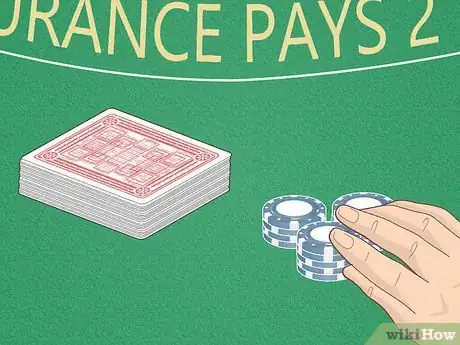
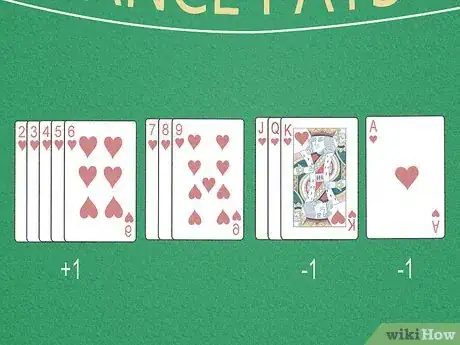
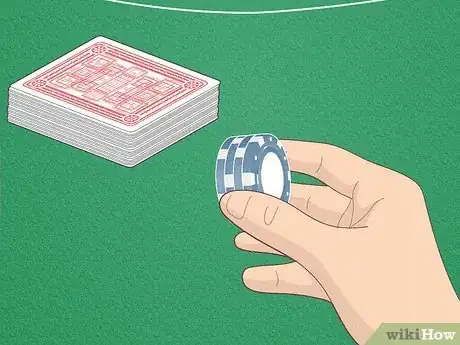
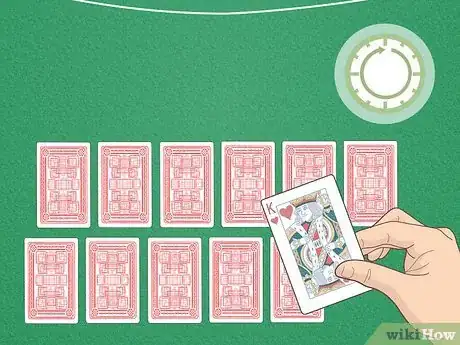
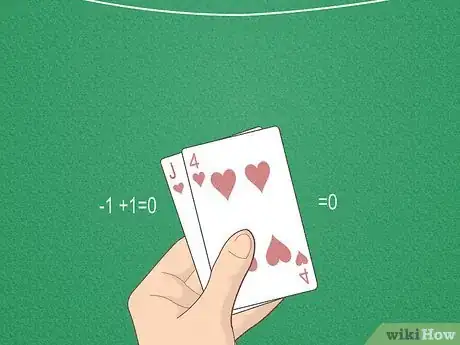
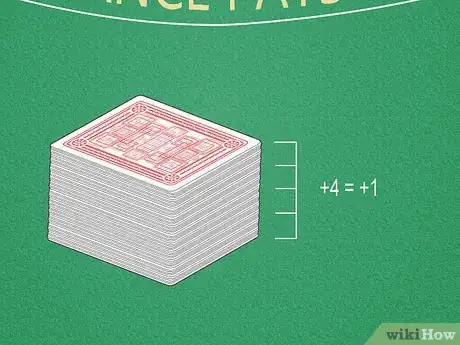
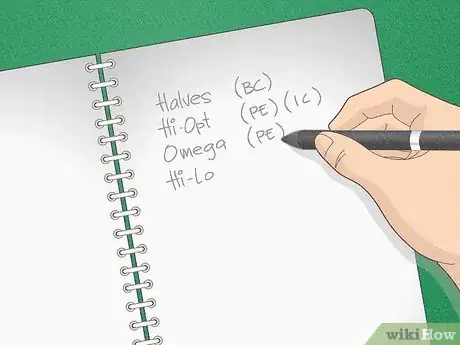
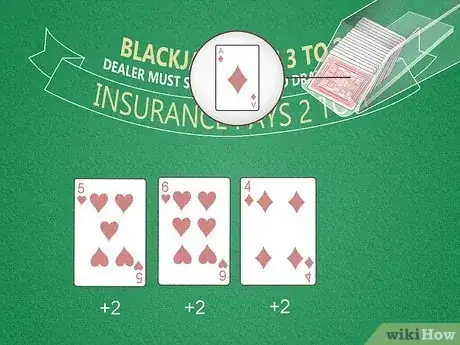
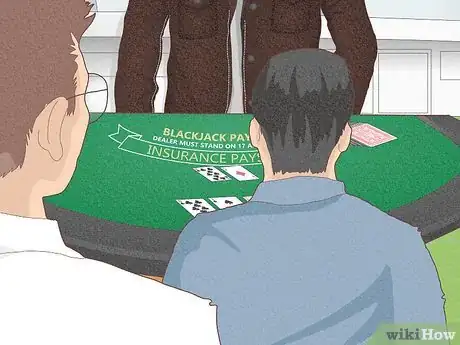
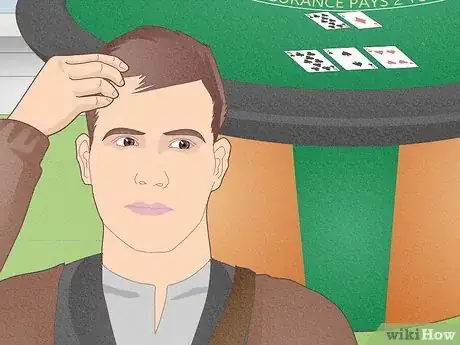
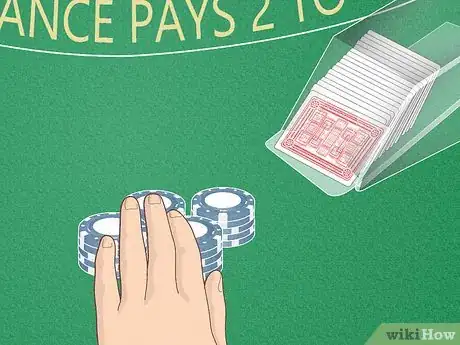
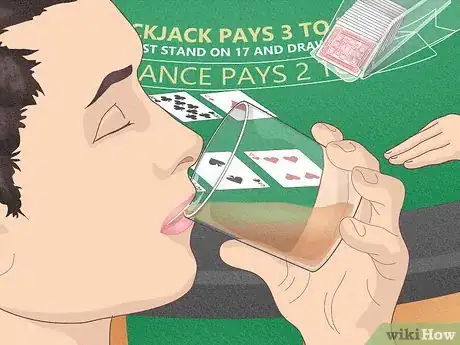
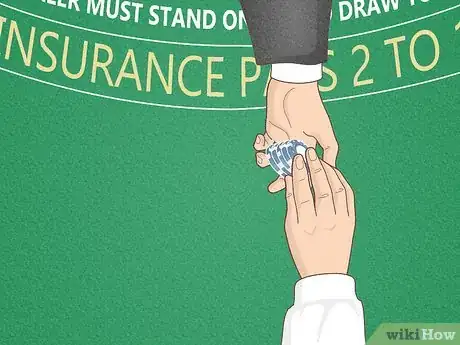
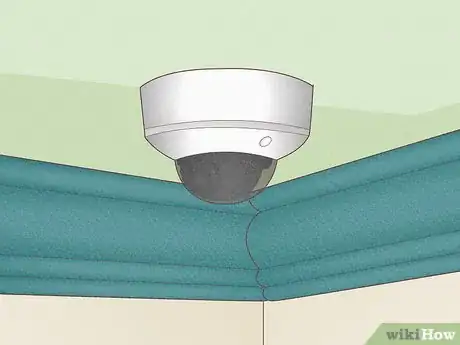
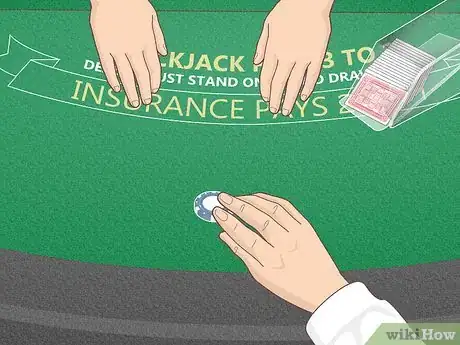
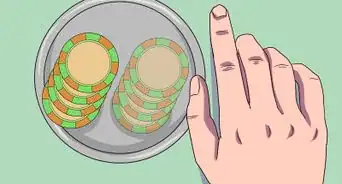

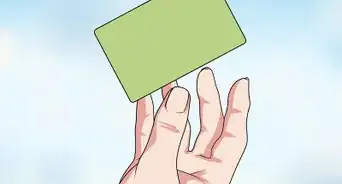
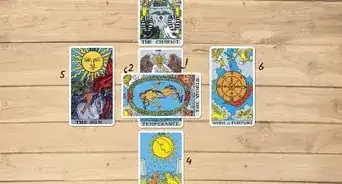


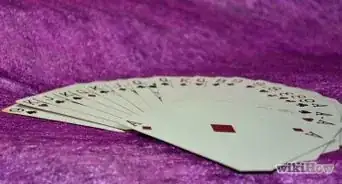











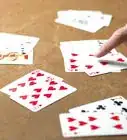

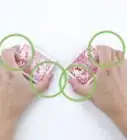
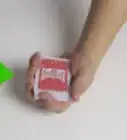



































wikiHow’s Content Management Team carefully monitors the work from our editorial staff to ensure that each article meets our high quality standards. This article has been viewed 1,234,868 times.